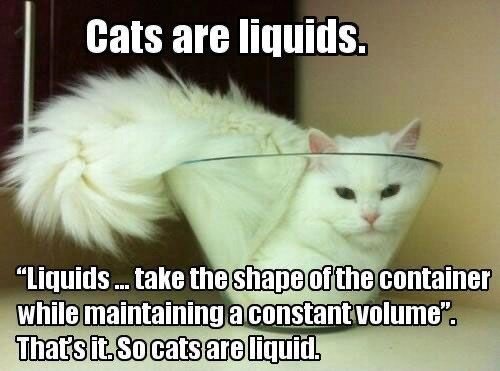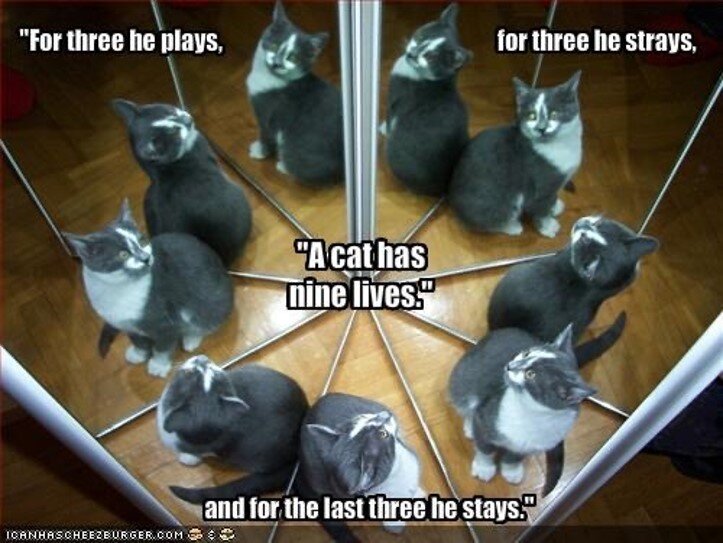Cats, as Explained in Memes: Why Cats are Liquid and Have Nine Lives
I gave this talk at my recent lecture salon birthday party! : )
Why cats are actually liquids
The definition of a liquid is "a material that adapts its shape to fit a container." Although we commonly think of liquids as items like coffee and beer, all observations seem to indicate that cats are also liquid. But how do they fit into spaces that they're larger than? How do cats seem to compress into whatever shape?
There are a few anatomical and physical reasons.
First, cats are super flexible. A cat’s front legs are attached to their shoulder via a very small, free floating clavicle (collarbone) by only muscles, not bones. This allows them to fit their bodies into tiny spaces, because their neck and shoulders can literally be squeezed to spaces tinier than you'd imagine and can be compressed through a hole or a tunnel. Cats are designed to want to hide in small spaces for safety and hunting reasons; then, when they spot their prey, they immediately race to catch them.
Cats also have very elastic spines, which contain more bones than human’s. Where humans only have 32-34 vertebrae, cats have 52-53. Although the majority of these vertebrae are in the tail, there are extra ones in the lumbar (between the hip bones and pelvis) and thoracic regions (between the cervical, or neck vertebrae, and the lumbar vertebrae) which also allow for more movement. They can rotate their spines more than most other animals can and the disks in between their vertebrae have a flexible, elastic cushioning.
Their flexibility and extra spiny spines allow them to reach and groom every part of their body. This is actually a survival technique, as they need to groom every part of their body to remove their scent, as that could give them away to other animals (predators or prey). Thus, there's an actual reason your cat is capable of licking its own butt.
Their flexible spines allows cats to contract and extend their backs in order to run faster, up to 30 miles per hour (but they’re sprinters, not marathoners). They can stride at three times their body length or more. (they can also jump up to nine times their height from a sitting position). Cats’ paws can turn in and out, which helps them climb, balance, and pivot. Cats walk and run on their toes (this characteristic is called “digitigrade”); this helps them run quickly and allows them to move silently. Their claws also help them run very quickly, acting like spikes to give them traction.
Cats are also known to be quiet and watchful. This again, ties into their natural abilities and need to hide in small spaces and then run very quickly and quietly to capture their prey. This is part of the cat habit often called “If I fits, I sits.”
It's also said that cats have nine lives and "always land on their feet." This refers to their "righting reflex," or ability to often survive falls from a great height, which derives from a number of unique evolutionary advantages.
In a 1987 study of 132 cats brought to a New York City emergency veterinary clinic after falls from high-rise buildings, 90% of treated cats survived and only 37% needed emergency treatment to keep them alive. One that fell 32 stories onto concrete suffered only a chipped tooth and a collapsed lung and was released after 48 hours.
First, cats can rotate their bodies 180 degrees to the right or the left. Humans can only rotate our hips around 90 degrees to the right or left. They also have the ability to turn their head and front legs in one direction and their hips and back legs in another direction. This allows them to turn and change direction very quickly, including while they're falling. This rotational flexibility allows them to quickly re-align their bodies and land safely.
Their tail in particular helps with this, as acts as a counter-balance that helps them adjust their weight around. The way they move as they fall also more evenly distributes impact throughout their body instead of on any one particular part.
Fun fact: The maximum speed of a falling cat, or its terminal velocity (the constant speed that a freely falling object eventually reaches when the resistance of the medium through which it is falling prevents further acceleration.) , will always be 60 mph, vs an average sized man’s terminal velocity is about 120 mph. Their small size, light bone structure, and thick fur decreases their terminal velocity. They also create wind resistance by spreading themselves out like a parachute, slowing down their speed.
Their actual instinct to right themselves comes from their inner ear, which acts as a compass so they always know when they’re right side up. Kittens have this righting reflex as early as 3-4 weeks (which is pretty amazing, considering kittens are born blind and without the ability to pee or defecate on their own, so they're...pretty damn helpless about everything for a while).
Cats' muscles and bones in their legs help them land in a way that decreases their chances of being hurt. Their long, muscley legs that divert energy into decelerating when they land rather than breaking bones. Their flexible, springy legs, increase the distances over which the force of the collision with the ground dissipates and increase the collision time over a longer period, reducing the overall impact force. Their bendy joints and the positioning of their legs, which are angled under their body, rather than extending downward (like a human or a horse's legs), allow their legs to bend instead of breaking.
Alas, they’re not invincible – about 90% of cats falling from tall buildings survive, but most sustain serious injuries. Cats that fall from 7-32 stories may be less likely to die than those that fall from 2-6 stories, but it's hard to tell, as studies indicate different results and these results may derive from survivorship bias, in that instantly fatal falls would not be taken to a vet.
All these abilities probably were evolutionary adaptations resulting from their need to be able to survive if they fall out of trees, where cats hang out A LOT in the wild, for safety and hunting reasons.
One of my favorite memes relating to this is the "the buttered cat paradox" - cats always land on their feet, buttered toast always lands buttered side down, If one attached a piece of buttered toast (butter side up) to the back of a cat, the experiment will produce an anti-gravity effect. This buttered cat can thus be used to produce energy.
I hope y’all enjoyed my silly cat post. :)











